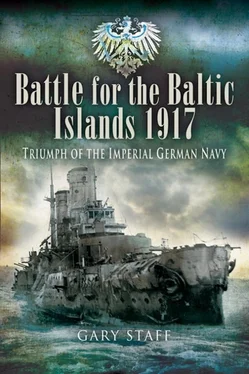The netlayer Eskimo continued to Kuiwast Roads and on 21 October, according to plan, laid a net barrier to the northwest of Schildau Island. The barrier was a double, 12 metre-deep net barrier, 3.25km in length. After laying the barrier Eskimo returned to Arensburg during the afternoon. The minelayer Nautilus was to have blockaded the channel east of Schildau with U-mines, but the water depth was too shallow and therefore the mines were loaded onto motorboats of the II Minesweeper Flotilla and were laid by them. Seventy mines were laid, after which Nautilus returned to Arensburg.
The Special Unit had successfully completed, and in some cases overstepped, its operational tasks. On the morning of 20 October the Admiralty Staff proposed a request to dismantle the Special Unit and Vizeadmiral Ehrhard Schmidt fully concurred and immediately answered:
Dissolve the Special Unit on 25 October. Hand over the remaining lines of communication and escort duty to BdAdO, whose forces shall include the S-Flotilla, the Net Barrier Unit of the Baltic, Nautilus , the 7th Torpedoboat Half Flotilla and one sperrbrecher , which are considered adequate forces. Kaiserin and König Albert can immediately be detached from Putzig to the North Sea. The Fleet Train can assist the transports of the II [Transport] Section to transport troops away from Arensburg to Libau. Traffic to Dago available shortly when mine-free channel in Kassar Wiek and Soelo Sound effected.
Vizeadmiral Schmidt had not desired to prolong the operation any longer than necessary, and he fully appreciated the importance of having the most powerful fleet units fully action-ready in the North Sea.
Nevertheless, during the course of the night of 21 October the Army High Command requested the Admiralty Staff to temporarily occupy the island of Kyno and make frequent demonstrations against the Lithuanian coast with its ships. The Admiralty Staff consented and the task was given to the 2nd Admiral of the III Battle Squadron, Kontreadmiral Seiferling, who was allocated Markgraf , Strassburg , five torpedoboats, the sperrbrecher vessel Lothar and the 3rd Minesweeper Half Flotilla. The demonstration was scheduled for 25 and 26 October, whilst a proposed operation to occupy the island of Worms was rejected. At about 1000hrs on 25 October the unit passed through the vessels anchored in Kuiwast Roads and took course south. Off Larina Bank the 3 MSHF took station ahead of the group with their minesweeper gear deployed. Frequent slipping of the gear in the shallow water caused continual delays so that it was only at 1600hrs that Markgraf arrived in the proposed bombardment position, 3 nautical miles off Kyno lighthouse. Shortly afterwards Markgraf opened fire with her starboard medium-calibre battery at ranges of 4,800 to 5,200 metres. After the bombardment, Markgraf continued southwards and, shortly after 1900hrs, anchored 12 nautical miles southwest of Salis. At around the same time, Strassburg , Lothar and four torpedoboats, which had been delayed by the sperrbrecher ’s low speed, anchored 15 nautical miles west of Hainasch.
The following morning, Markgraf continued the operation so that at around 0740hrs she was able to bombard Hainasch with seventeen shells from her starboard medium-calibre guns at a range of around 11,000 metres. Then, suddenly, just as Markgraf ordered the preceding 3 MSHF to turn onto a westerly course, the sweeper gear of T65 fouled a mine and exploded it. The stern of the minesweeper was rent open but the boat remained afloat for twenty minutes before capsizing, allowing the entire crew to be saved. The minesweeper unit had pushed onto a Russian mine barrier that had been laid after the fall of Riga to protect the seaward flank of their XII Army. The bombardments concluded when Strassburg shelled Salismunde at 0800hrs with some fifty-five rounds. After this the German ships retired, again in the wake of the 3 MSHF and took course on Arensburg, at the direction of Vizeadmiral Schmidt. On the morning of 27 October the unit anchored safely inside the net barrier on Arensburg Roads.
The further demonstrations desired by the Army High Command (OHL) were to be conducted by Markgraf alone, until she could be replaced by the ships of I Battle Squadron. Therefore the chief of the Special Unit detached König and Kronprinz to the North Sea. They quit Kuiwast Roads on the morning of 26 October but their journey home was not without incident. The sea was rough and there was a strong southwest wind so that when they were between Windau and Backofen at around 1744hrs, both ships scraped the bottom. In the rising seas it was reckoned that the pitching ships’ draughts approached 12 metres and the area was known to have many uncharted rocks. Both ships later required docking for repairs to their double bottoms.
On 28 October, the 1st Division of the I Battle Squadron arrived in Putzig Wiek. On 30 October, the reconnaissance group IV AG, consisting of the cruisers Regensburg , Stralsund and Pillau arrived in Pillau. After replenishing their coal stocks in the Putzig Wiek, Ostfriesland and Thüringen were expected in Arensburg on 30 October. Markgraf was no longer required and Vizeadmiral Schmidt detached her to the North Sea also. At midday on 29 October Markgraf quit Arensburg Roadstead, escorted by G89. At 1430hrs Markgraf was about 8 nautical miles north-northwest of Michael’s light, travelling in the buoyed channel, when suddenly she was rocked by two mine detonations in rapid succession. Three wing passage cells on the starboard side filled with water, for a total of 260 tonnes. Fortunately, there were no personnel losses and the ship was able to hold her course and speed. At first Markgraf went to Neufahrwasser, then on to Kiel, where, on 1 November 1917, Kontreadmiral Seiferling disembarked before the battleship continued to Wilhelmshaven. From 6 to 23 November she was repaired in the Imperial Dockyard.
In the buoyed channel, it appeared that a marker buoy had been displaced by the currents and stormy weather, although perhaps some of the mines of barrier 2 had been missed. The BdAdO ordered the 8th Minesweeper Half Flotilla to examine the mine-free channel that same day, but no further mines were found.
Vizeadmiral Schmidt now took a strong stance against further demonstrations inside the Riga Gulf. The recent storm meant that mines and buoys were continually drifting and there were only a few narrow swept channels for the large ships. The autumn also brought periods of poor visibility which meant it was often impossible to obtain a position fix. The chief of the Special Unit telegraphed his concerns to the Admiralty Staff, pointing out that the gains of further operations were minimal, whilst the risks were great, and recommended that all forces of the High Sea Fleet, including the I Battle Squadron and IV AG, should return to the North Sea. The OHL agreed and corresponding orders were raised on 31 October; after a very successful operation it seemed pointless to risk major losses in mopping up.
Vizeadmiral Schmidt handed over command to Kontreadmiral Hopman and, early on the morning of 2 November, he departed Arensburg Roads with Moltke , Ostfriesland and Thüringen for Putzig Wiek. The unit arrived there on the morning of 3 November whereupon Vizeadmiral Schmidt transferred to his old flagship, Ostfriesland , and detached Moltke to the North Sea. A telegram from the Admiralty Staff later that day dissolved the Special Unit. Vizeadmiral Ehrhard Schmidt dismissed himself on the following day and conveyed the following message to the forces hitherto under his command:
Читать дальше












